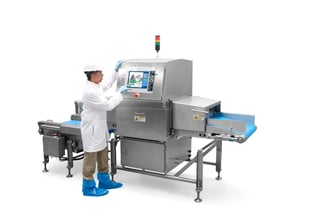 In previous posts, we’ve discussed the benefits of metal detectors and of x-ray inspection machines for quality assurance. Each type of product inspection equipment has its own benefits and drawbacks, and both technologies have continued to improve over time, with inspection machines becoming more capable.
In previous posts, we’ve discussed the benefits of metal detectors and of x-ray inspection machines for quality assurance. Each type of product inspection equipment has its own benefits and drawbacks, and both technologies have continued to improve over time, with inspection machines becoming more capable.
What are the benefits of each type of product inspection machine?
Here are a few examples:
Benefits of Using Metal Detectors for Food Inspection
- Able to Detect All Metal Contaminants. All metals have some amount of magnetism or electrical conductivity, or both. Metal detectors specifically check for magnetic and electrical interference, allowing them to detect any metallic object with ease, even lighter metals such as aluminum that would be harder to detect with x-ray inspection.
- Great for Bulk/Gravity Flow Products. Because metal detectors check for electromagnetic interference rather than a grayscale image, they excel at detecting contaminants in bulk or free-flow production lines.
- Economic Product Inspection. On average, metal detection systems tend to be less complicated and expensive than x-ray systems. This not only means lower up-front costs for adding metal detection to your production line, but lower maintenance costs over time as well.
Benefits of Using X-Ray Inspection Machines for Food Inspection
- Wider Variety of Detectable Contaminants. X-ray food inspection machines can detect more than just metal. Rocks, glass, bone, and dense plastic/rubber can all be detected using x-ray inspection technology, all things which metal detectors would miss.
- Fill Level Inspection. Because x-ray machines take a grayscale snapshot of product packages, they can be used to establish a quick pass/fail system for fill level of loose-packed products such as potato chips, cereal, or chocolate milk powder.
- Check-Weighing. X-ray machines can take a three-dimensional image of products to measure their overall mass to see if a given product falls within an acceptable weight range.
- Not Affected by Metalized Packaging or the State of the Product. One thing that metal detection has difficulty with is spotting stray metallic objects through another metallic container. X-ray inspection technology, on the other hand, is able to pick up contaminants even if your packaging includes metalized components such as: Metalized film, metal caps, metal cans, aluminum tray, etc. Furthermore, X-ray technology is not affected by the state of the product. This will reduce the potential for false rejects even if your product is frozen, semi-frozen, fresh, hot, cold, etc.
- The grayscale x-ray images from an x-ray inspection process can be saved for future reference. X-ray systems also store the inspection characteristics of each individual product for future evaluation. This improves documentation for quality control and makes each package more traceable than with metal detection.
Using Both to Overcome the Limitations of Each
Both of these technologies are highly useful for reducing your risk of allowing contaminated food packages to leave your factory. However, each of these technologies have their own specific weaknesses as well.
For example, x-ray machines often have difficulty detecting less dense objects such as aluminum. A metal detector, on the other hand, may be able to spot slivers of aluminum that an x-ray machine might miss.
One weakness of metal detectors is that some dry or wet foods can trigger false positives. The iron in enriched dry foods can sometimes be enough to trigger a contamination warning, while the salt and moisture in wet foods (like cheese) can make them conductive, which also creates a false positive. X-ray machines are not affected by the state of a product (fresh, frozen, semi-frozen, cold, hot, etc.) or salt/moisture content thus reducing false rejects.
If you have the budget for adding more than one inspection machine to your line, consider using both metal detection and x-ray inspection equipment on your production line. By using both machine types, you can use the strengths of one to cover the weaknesses of the other.
For example, you could place a metal detection device at a critical control point (CCP) near the start of your production line to check loose, raw ingredients for signs of metal contamination. This would help keep loose metal from getting caught in your production equipment, improving food quality and reducing wear and tear on the equipment.
Near the end your production line, post packaging, you could set up an x-ray inspection machine to check the individual product packages for various metallic and nonmetallic contaminants that the upfront detector may have missed (or may have been introduced during production). This would pick up things that you couldn’t with metal detection alone.
If metal does frequently make it into your packages, there’s a solid chance you have a source of contamination in your production line after the initial metal detection is done. This gives you a chance to narrow down the source of the contamination and rectify it.
In conclusion, in most cases, the best inspection solution is a combination of multiple inspection technologies.
Want to learn more about how to detect previously undectectable contaminants? Click below:



